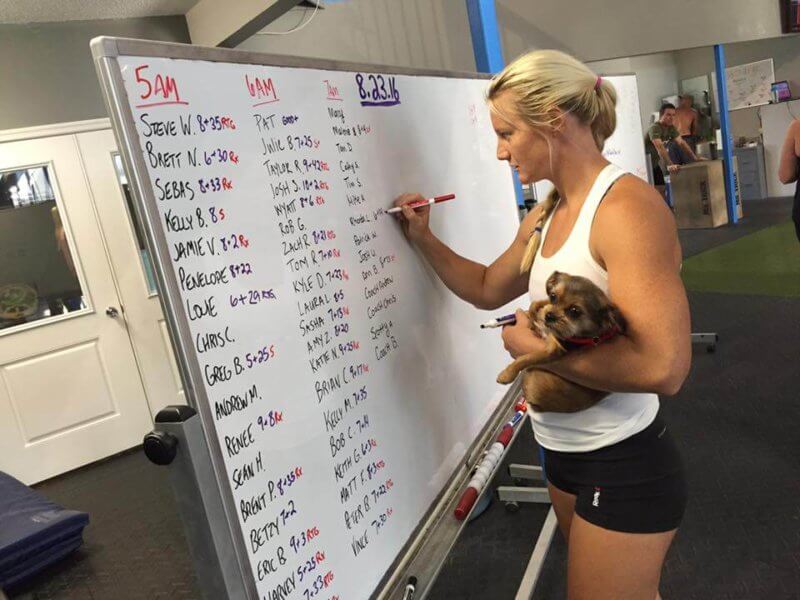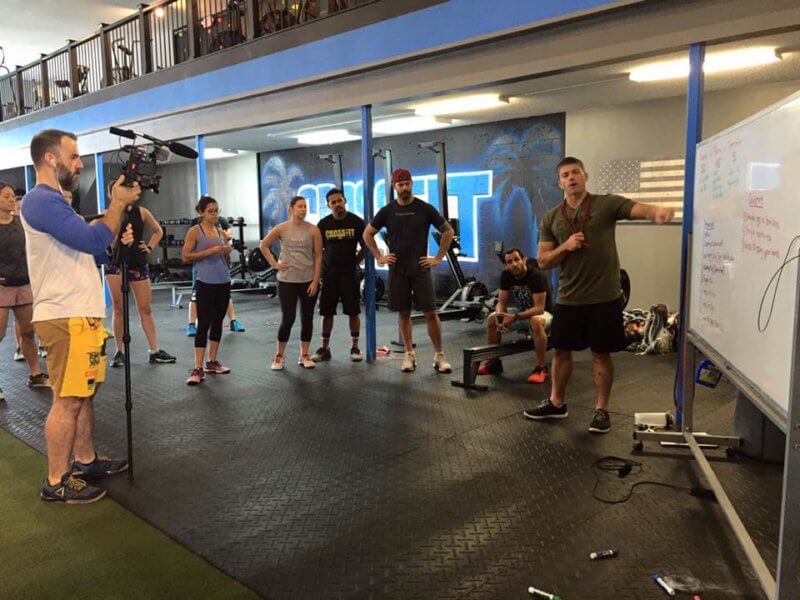CROSSFIT PALM BEACH CASE STUDY


BUSINESS PROFILE
After four years of using a traditional whiteboard in all of their CrossFit® classes, CrossFit Palm Beach recently decided to do away with it. They have replaced it with Zen Planner for digital attendance and workout tracking, and are happy they made the switch.
While they loved the physical whiteboard and believed it offered several benefits, they ultimately felt they could provide more value to their members by switching to an automated version. This was something they went back-and-forth on for months before finally making the switch. If you are thinking about making the switch in your box, here is the thought process they followed that ultimately convinced them to change, and might even convince you to do the same.
HOW THEY USED THE WHITEBOARD
For the last four years, their process of using the whiteboard has pretty much stayed the same. At the beginning of class, one of the coaches would write everyone’s name on the board. This would usually take place in the minutes before class as people arrived or during the warm up. At the end of the workout, members would walk up to the board and tell the coach their scores and whether they did scaled, RX or RTG, and the coaches would record their score next to their name. This process generally took a few minutes before class and a few minutes at the end of class, and was mainly the responsibility of their coaches to perform and enforce.
WHY THEY LOVED THE WHITEBOARD
1). Helped coaches remember names. There is something magical about writing a person’s name and score on a whiteboard that helps you remember them in the future. Remembering and using people’s names is such a huge part of building a strong community, and the physical whiteboard definitely made this easier.
2). Helped members get to know one another. They found that members would learn the names of other people from different classes, even before they had actually met them, simply because they consistently put up similar scores as one another. The early morning classes never had this luxury, but it was something the afternoon members greatly appreciated.
3). Guaranteed way of measuring progress. While they always encouraged people to track their own scores, the physical whiteboard guaranteed that they would have their scores saved so they could revisit them in the future. They would always take a picture of the whiteboard at the end of the day and post it to the website blog. This allowed people to pull up scores from old benchmark workouts, even if they forgot to record it themselves. As we all know, measuring progress is a huge element of CrossFit®, so they loved this aspect of the whiteboard.
4). Provided a quick snapshot of what to expect. It was easy to walk up to the whiteboard later on in the day and see a summary of all the times and scores from that given day. This gave people a general idea of what to expect from the workout, as well as a goal to shoot for. It pushed members just a little bit harder. As Greg Glassman has said many times before, “people will die for points”. Many members have expressed how much harder they have pushed just because they know their score was going on the board to be seen by everybody. Accountability is huge.
CONS OF THE WHITEBOARD
1) It wasted too much of our coaching staff’s time. This was the ultimate reason we decided to do away with the whiteboard. As our gym has grown and classes have gotten bigger, we had to make a decision of whether it was more valuable for a coach to spend his/her time writing names and scores on the board, or utilizing that time to say hi to members, develop relationships, find out about injuries or simply congratulate members after a tough workout. What we were finding is that in classes where we started to have 15, 20 or 25+ people, this meant a coach would typically spend at least five minutes at the end of class tracking people down to record their scores. Post-WOD is such a great time to deepen your relationships with your members. They are proud of themselves for finishing their workout, their guards are down and a lot of them just want to talk and share how the workout felt or something they accomplished that day. It’s also a great time to reinforce cues or positive changes that were made during the workout. If our coaches are spending that time with their back to the class trying to record scores on the board, they are missing out on a huge opportunity. As classes grow bigger, this only becomes worse. There are more people to talk to and build relationships with, but less time to spend building those relationships.
2) Sometimes having a goal to shoot for means selling yourself short. When I asked Steve Walker, one of our most consistent 5 AM members, how he approaches workouts not knowing any scores from previous classes, he said “I just give everything I have, every day”. While having a goal to shoot for is great, picking an arbitrary goal based on someone else’s score is not always beneficial. It can also lead to stress about the end result instead of allowing your members to focus on simply giving their best effort.
3) When we emphasized the whiteboard too much, it got in the way of long term progress. You can only improve so much through competition. If you are only worried about your score at the end of a workout, you are spending too much time competing, and not enough time practicing and training. Eventually, if you want to see long-term progress, you need to take a step back and sacrifice your score today in order to put up even better scores months and years from now.
4) Dishonesty. Cheating reps is more common than most gym owners would like to believe. While this will happen regardless of the whiteboard, we found it to be a lot more prevalent when members were forced to put their scores on our traditional whiteboard. Members get too focused on looking good rather than just working hard. By de-emphasizing the whiteboard, we found the pressure to cheat reps decreased significantly.

WHY THEY SWITCHED TO ZEN PLANNER
1) Coaches can be fully present in class. With Zen Planner, coaches can now spend all their time coaching, building relationships and maximizing the full 60-minute experience. When they did away with the whiteboard, Andrew said they were able to fit in cool downs more often and wrap up class in a more organized and structured way. This provided a much better 60 minute experience, rather than just a great workout.
2) Better long-term attendance tracking. Andrew admits that it was tough getting their members to sign in and record their scores at first, and it is still something they are still working to improve. Once everyone is in the habit of doing so, Andrew says they will have much better data to make short and long term business decisions. While this initially a challenge in the short-term, the long-term benefits have made it worth it.
3) Members love the App and leaderboard. “The App and leaderboard are pretty cool,” says Andrew. “You can see live updates of people’s scores throughout the day, which is something that wasn’t possible before. You can easily look up old lifts and benchmark workouts. You can also add individualized notes on how you scaled, how you approached the workout or how you felt that day. There is a social element to the Zen Planner App as well. People can like and comment on other’s scores and congratulate them on a PR or great workout. While it’s taken a couple months to get used to, we are seeing that many members now prefer the digital whiteboard and are really enjoying the social element that extends outside the walls of the gym.”
Zen Planner has helped CrossFit Palm Beach for beyond just workout tracking. They recently had their best month ever surpassing $50,000 in monthly revenue. “I just don’t see how this would be possible without Zen Planner,” says Andrew. “The software is easy enough to use where I can have my team take over most of the administrative side so I am freed up to spend more time developing our coaches and shaping our culture and community.”
Andrew says, “Zen Planner has honestly evolved to feel like a consultant to our business, not just a software company. I have regularly used them to bounce ideas off of or to proofread emails or policy changes.They have allowed us to track key metrics that we can use to make long term business decisions, and they have helped us to stay organized through digital waivers, contracts, payments, attendance and workout tracking.”
BENEFITS
- Saves significant time each week, allowing coaches to focus on building relationships, rather than recording scores
- Enabled CrossFit Palm Beach to surpass $50,000 in monthly revenue
- Grow community by allowing members to like and comment on one another’s scores
- Increased attendance by encouraging sign-ins through their Committed Club program
- Offers better data, allowing them to make more informed business decisions






